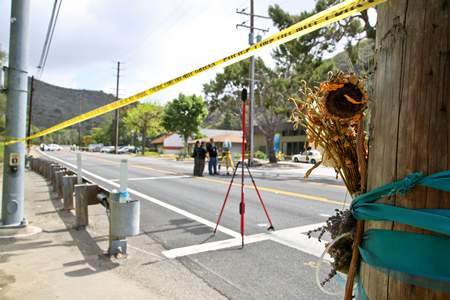A plan to improve the safety and beauty of Laguna Canyon Road by burying utility poles underground hit a roadblock Tuesday due to the projected costs and necessity of road closures.
Design for the project to place the utility wires beneath the ground along the Big Bend section of Laguna Canyon Road, begun about five years ago, is now complete and the necessary permits in hand, said a staff report prepared for this week’s City Council meeting. Construction could begin in September and take up to six months to complete.
But the City Council refused to green light the project as configured, with the caveat that they might consider a scaled back plan to bury the poles along a shorter stretch of roadway after staff has a chance to recalculate the figures.
The city holds $2.8 million in hand for undergrounding accrued through credits from the electric company granted through a Public Utilities Commission tariff that are earned over time and can also be purchased from other cities. They targeted the Big Bend section for the first use of those credits because it’s where cars most frequently crash into the poles.

But the project as presented Tuesday will not result in the expected pristine stretch of roadway unmarred by overhead utilities. Wires stretch across 34 poles in the district, but only 16 poles will actually come down due to cost and construction constraints, the report says.
The 11 tallest poles carry transmission lines that bring power into town and must remain, said Public Works Director Steve May. Additionally, seven of the shorter poles will have to stay up to support their tall brethren, though their phone and cable utility wires will be buried, he said.
“To underground the large poles is an immense cost,” said Southern California Edison representative Todd Pierce, since they need to be buried in separate deeper trenches, 10 feet apart. In fact, undergrounding those poles alone would take three years of planning and cost $6 million, the staff report says.
What’s more, it would take six months of digging alone and incur traffic closures, Pierce said.
Meanwhile, putting the remaining 16 poles below ground will also require partial road closures.
During the four- to six-month construction period, one lane of traffic will remain open in each direction, with one exception, said May. In order to dig a tunnel under the roadway, there will be a two- to three-week period with a single lane open, where pilot cars will lead drivers through a closure zone of about 500 feet, alternating for north- and southbound traffic. It could be a huge traffic problem, said May. But with proper signage and advance notification about the disruption, people could live with it, he said.
“First of all, we need to focus on the actual benefits,” said Pierce. Even with the transmission poles remaining above ground, the “benefit you will see going through the canyon is immense,” he said, advocating to move forward with the project.
“The public needs a bigger bang for their buck,” countered Verna Rollinger, a member of a city task force evaluating six options for reconfiguring Laguna Canyon Road that are all dependent on the complete undergrounding of the utility poles that flank it. Completing half the project doesn’t justify reducing travel to one lane for two to three weeks, she said.
It would be better to underground all 34 poles at once, even with the added time and money, especially since no plans for improving the roadway will be viable unless the poles are all removed, Rollinger said.
Mayor Pro Tem Steve Dicterow agreed. “I want to do this project, but I want to do it right,” he said.
Council member Toni Iseman also questioned how much safety would actually improve with so many poles remaining.
The Council might prefer to simply underground one section of nine consecutive distribution poles where there are no transmission poles, Pierce suggested.
“I think the Council’s on the right track,” said Mayor Bob Whalen, reiterating a shared sentiment that there’s no point in leaving some poles up on a given stretch of roadway where the others are undergrounded, just because of costs. “I’m not put off by the $6 million,” he said, adding that city staff can come up with a plan for a more comprehensive approach.
That said, he and the Council members agreed to consider using currently available funds for the nine-pole section Pierce proposed once staff reports back on the cost.
Clarification posted April 10:
The story “Big Bend Undergrounding Hits Road Block” published in the April 3 edition refers to “burying” utility poles when, in fact, the poles themselves are simply taken down, not buried. Only the utility cables attached to the poles get buried





[…] task force has been at work for nine months, working on ways to improve the major artery into town. Burying utility poles has already been identified as it top priority. Other items under study include improvements for […]
[…] PUC already requires utility companies to set aside funding for undergrounding utilities in specific cases, but Laguna officials are dissatisfied with […]
[…] PUC already requires utility companies to set aside funding for undergrounding utilities in specific cases, but Laguna officials are dissatisfied with […]
[…] report on the Big Bend undergrounding project reviewed last week has been delayed for a year due to questions regarding the cost and breadth of the project and to complete other […]
[…] Laguna Canyon, the breakdown of undergrounding from downtown to Big Bend will involve removal of 85 poles over 7,000 feet at an estimated total cost per-mile range of […]